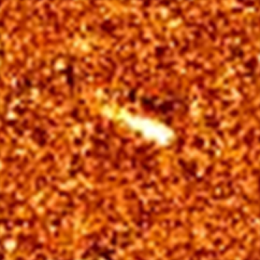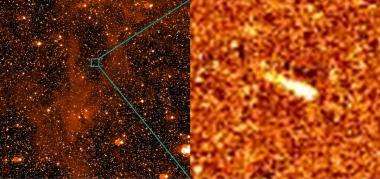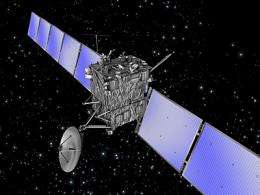When is a comet not a comet? Rosetta finds out

(PhysOrg.com) -- It was a case of celestial hit and run. Two asteroids, both in the wrong place at the wrong time. The result: one big trail of debris and a case of mistaken identity. Now, however, ESA’s comet-chaser Rosetta has unravelled the truth.
In the first half of February 2009, two asteroids collided in a region of space beyond the orbit of Mars, as scientists from the Max Planck Institute for Solar System Research (MPS) in Germany have now discovered. The researchers were able to pinpoint the exact date of the impact more precisely than ever before. The debris of the crash had attracted the attention of scientists worldwide. Together with the largest earthbound telescopes and the Hubble Space Telescope, the OSIRIS camera system onboard ESA’s space probe Rosetta, that was developed and is now operated under the lead of the MPS, took a close look at these remains. The space probe’s unique viewpoint, combined with detailed computer simulations, allowed the scientists from the MPS to reconstruct the collision precisely. Until now, such a recent clash of two asteroids was unknown. (Nature, October 14th, 2010)
Several million large and small fragments of rock populate the so-called asteroid belt, the region of space between the orbits of Mars and Jupiter. During their journey around the Sun, time and again such asteroids collide. Due to the immense expansion of the asteroid belt, most of these incidents are not discovered. Major collisions that happened thousands to millions of years ago have been inferred from the presence of diffuse bands of dust spreading across the whole sky, and families of asteroids with similar orbits. Most of what scientists know about collisions between asteroids comes from the study of these fossilized remains, a sort of space paleontology.
"In comparison, it was practically yesterday that the asteroid named P/2010 A2 bumped into a small rock with a diameter of only a few metres", says Dr. Colin Snodgrass from MPS. The trail of debris from the collision is still directly visible to astronomers with large telescopes, and scientists have been excited to be able to study it in detail. "Imagine finding a fresh dinosaur body instead of having to figure out how they looked from fossils", adds Snodgrass.

In January 2010, scientists working on the LINEAR project (LIncoln Near-Earth Asteroid Research) stumbled across the asteroid P/2010 A2 during routine scans for asteroids near Earth. Because of its appearance, scientists initially believed the cosmic chunk to be a comet - and gave it a name based on the common cometary nomenclature. In the following months, however, more precise studies revealed its true nature.
Crucial for the right classification is the shape of the trail of debris and its evolution in time. "In order to judge both, the perspective is extremely important", explains Snodgrass. Since the orbits of Earth and the asteroid lie nearly within the same plane, all pictures taken from Earth show only a projection of the trail. From this point of view it is therefore difficult to discern its true length and shape. This constriction also holds true for the powerful Hubble Space Telescope, since - compared to cosmic distances - it circles Earth in close proximity. Only the Rosetta space probe, which was well beyond the orbit of Mars when it observed the trail in March 2010, experienced a completely different view: The orbits of Rosetta and the asteroid are tilted with respect to each other.
The situation can be compared to watching a locomotive approaching frontally. From this perspective, it is difficult to estimate the length of the row of cars attached. Only when changing the location, for example to a point further above the train, can the whole length of the train be seen.
"With the help of the images from Rosetta we could see the true three dimensional shape of the trail", says Snodgrass. This shape is not typical for a comet continuously emitting material and points to the trail of debris due to a collision of asteroids. Together with further images taken from Earth, these pictures allowed the researchers from MPS to reconstruct exactly how the trail had evolved in time. They fed their computer program with an initial assumption about the size of the currently visible grains of debris. In a next step they calculated how the distribution of these grains evolves in time. "By comparing these results with the actual distribution, the assumption for the size can be refined step by step - until the exact reconstruction is found", explains Dr. Jean-Baptiste Vincent from MPS, who performed the simulations.

With their method, the scientists from MPS could pinpoint the date of the collision to a window of ten days around February 10th, 2009. The size of the grains of debris they calculated to be at least one millimetre. In addition, these calculations offer a unique understanding of the initial phase after a collision of two asteroids.
In addition to being of scientific interest, the result is a significant technical accomplishment for the Rosetta spacecraft. The dust trail is so faint that the largest ground based telescopes (with apertures of up to ten metres) and the Hubble Space Telescope were used to observe it from Earth. The OSIRIS camera is around 7000 times less powerful than the biggest ground based telescopes. "The OSIRIS camera is more like a telephoto lens than a telescope, it is designed to take detailed images of a comet from close range", explains Dr. Cecilia Tubiana, who led the processing of the images from Rosetta at MPS. "Although far from Earth, Rosetta was still millions of kilometres from the P/2010 A2 collision, and the debris trail appeared as a very faint streak against the background stars", adds Dr. Holger Sierks, principle Investigator of the OSIRIS-Team. Careful combination of four hours worth of images was required to make this observation.
ESA’s space craft Rosetta has been on its way to the comet Churyumov-Gerasimenko since 2004. Rosetta will reach its destination in 2014. The scientific camera system on board called OSIRIS was developed and built at MPS. In July, OSIRIS took detailed images of the asteroid Lutetia during flyby.
More information: Colin Snodgrass et al. A collision in 2009 as the origin of the debris trail of asteroid P/2010 A2, Nature, October 14th, 2010.
Provided by Max-Planck-Gesellschaft




















